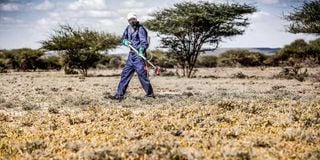Premium
UN releases Sh164m for fight on locust upsurge

A member of National Youth Service sprays pesticides in an area infested with hopper bands of desert locust next to Lokichar, Turkana County, on June 9, 2020
What you need to know:
- The funds will mainly be used in control operations, including air and ground surveillance and pesticide spraying.
- Last month, FAO appealed for additional funding to enable it to scale up operations against the pests in East Africa.
The United Nations has set aside Sh164 million from its Central Emergency Response Fund to fight a possible desert locust upsurge in Kenya.
The funds will mainly be used in control operations, including air and ground surveillance and pesticide spraying.
Swarms have so far been reported in Mandera, Garissa, Marsabit, Tana River and Wajir.
Undersecretary-General Mark Lowcock, the UN humanitarian chief, on Tuesday announced the release of the money to the Food and Agriculture Organization (FAO).
"I am allocating Sh164million ($1.5m dollars) from UNCERF for desert locust control operations in Kenya," Mr Lowcock announced on his Twitter handle. Mr Lowcock revealed that since early 2020, locusts control in Eastern Africa and Yemen has affected production of food enough to feed 18 million people for a year.
Mr Farhan Haq, deputy spokesman for UN Secretary-General Antonio Guterres said that since December 21 last year, numerous swarms started to form in Eastern Ethiopia and Central Somalia following Cyclone Gati — the most powerful tropical storm ever to hit Somalia.
"They have been entering into northeast Kenya and are likely to spread throughout northern and central counties," Haq said.
FAO expects its locust response plan to run until June but urgently needs more funds to contain the threat from desert locusts in the region. According to FAO, if not controlled, the swarms could destroy crops and pasture and threaten the livelihoods and food security of 3.6 million people across the region and in Yemen.
Last month, FAO appealed for additional funding to enable it to scale up operations against the pests in East Africa.
So far, partners and donors have committed Sh22.3 billion to support FAO efforts.
The funding has allowed FAO and governments to rapidly scale up locust response capacity in a region that has not faced an upsurge of the pest on this scale in decades.
FAO said over 1,500 ground survey and control personnel have been trained and 110 vehicle mounted ground sprayers. Further, 20 aircraft are now in action.
A new generation of desert locust swarms is threatening agricultural and pastoral livelihoods and the food security of millions of people in the Horn of Africa and Yemen despite intense efforts to control the pests throughout 2020.
According to FAO, control operations have prevented the loss of an estimated 2.7 million tonnes of cereals worth nearly Sh89.2 billion in countries already hard hit by acute food insecurity and poverty. FAO is assisting governments and other partners with surveillance, coordination and technical advice.
Families who have lost their crops have been given cash compensation so that they can cope with shortage of food. Over 200 000 households have already received livelihood assistance and that number is expected to increase.
FAO will assist an additional 98 000 households this month and is appealing for humanitarian assistance.




